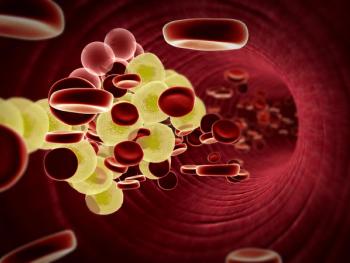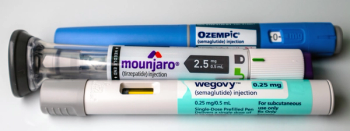
- August 2022
- Volume 88
- Issue 8
Reducing Dietary Sodium Is Key for Older Adults With Hypertension
Advise restriction of the nutrient, along with intensive BP control, regimens promoting adherence, use of chlorthalidone in CKD.
Twenty years ago, the ALLHAT trial (NCT00000542) definitively identified high blood pressure (HBP) as a primary risk factor for cardiovascular disease (CVD) and death.1,2
Recent research has identified some topics that are important for older adults with HBP: dietary sodium, combination dosage forms, chlorthalidone, and intensive control.
Dietary Sodium
Dietary sodium reduction is a key intervention to prevent HBP and lower elevated blood pressure (BP).3-6 Yet sodium’s ubiquitous presence in food makes sodium reduction difficult for patients. Some experts have questioned sodium restriction’s necessity, especially in adults with BP lower than 140/90 mm Hg.7 Other experts question the methods employed in older studies.8 A recent meta-analysis of 4 cohorts used stronger methods than previous work to measure 24-hour urinary sodium and potassium. Higher sodium excretion, a higher sodium-to-potassium ratio, and a lower potassium excretion were all associated with higher CVD risk after controlling for confounding factors.9 A 1000-mg increase in daily sodium excretion increased CVD risk by 18%. Conversely, a similar change in potassium excretion was associated with an 18% decrease in risk.9
Another team used a meta-analysis of 81 clinical trials and found a nearly linear dose-response relationship between sodium intake and BP; a 100 mmol/day (~2300 mg, or 0.5 teaspoonful) reduction in sodium reduced systolic blood pressure (SBP) by 5.43 mm Hg in adults, regardless of baseline BP.10
These findings back the American Heart Association’s recommendation that individuals with HBP consume less than 1.5 g sodium/day and are consistent with other advisory bodies’ recommendations to limit sodium to less than 2.3 g/day.11-13 Any reduction in dietary sodium intake should be beneficial.9 The results of small studies have previously suggested that salt substitutes with less sodium and more potassium lower BP, but they have not looked at cardiovascular (CV) outcomes.14 A 2021 open-label, cluster randomized trial (n = 20,995) enrolled individuals with histories of hypertension (HTN) or stroke who were at least 60 years old.15 They randomized 600 Chinese villages to either regular salt or a salt substitute containing 75% sodium chloride and 25% potassium chloride. After a mean follow-up of 4.74 years, participants in the salt substitution arm had significantly lower rates of incident stroke, major CVD events, and all-cause mortality than those in the salt arm.15
This simple, economical intervention could save lives.16
Single-Pill Dosage Forms
The 2017 American College of Cardiology/American Heart Association BP guideline recommends starting treatment for HTN with a single-pill combination. Its advantages include avoiding clinical inertia and increasing long-term adherence.17 Proof for this concept is now available. The QUARTET USA study (NCT03640312) study randomized 591 untreated adults (mean BP, 141/85 mm Hg) to a quadpill (irbesartan 37.5 mg, amlodipine 1.25 mg, indapamide 0.625 mg, and bisoprolol 2.5 mg; 25% of the usual daily doses of each) or irbesartan 150 mg alone.18 After 3 months, 15% of the patients in the quadpill arm and 40% in the control arm needed additional antihypertensive medication. Quadpill arm participants’ SBP was 6.9 mm Hg lower, and BP control rates were 30% improved than the comparison arm; they maintained the improvements for up to 1 year.18 Low-dose single-pill combination therapy is well tolerated and effective for initial drug therapy of hypertension.
Chlorthalidone in Chronic Kidney Disease
In patients with advanced chronic kidney disease (CKD), even combining calcium channel blockers, loop diuretics, and renin-angiotensin system inhibitors often fails to control BP.19 When the estimated glomerular filtration rate (eGFR) falls below 45 mL/min/1.73 m2, hydrochlorothiazide does not induce predictable natriuresis. Longer-acting chlorthalidone and indapamide induce natriuresis when eGFR is as low as 30 mL/min/1.73 m2,20 and below that eGFR, guidelines recommend a long-acting loop diuretic.20 A recent study of patients with uncontrolled HTN (n = 160) and stage 4 CKD (eGFR, 15-30 mL/min/1.73 m2) randomly assigned participants to a placebo or chlorthalidone 12.5mg/day with increases every 4 weeks, if needed, to a maximum of 50 mg/day, plus their usual antihypertensives.21 Chlorthalidone lowered BP by 11 mm Hg compared with 0.5 mm Hg in the placebo arm and reduced proteinuria. The lowest dose of chlorthalidone had the best BP-lowering efficacy, and the investigators identified it as the safest dose for patients with CKD. An additional finding was that thiazide-like diuretics may protect target organs.21
Intensive BP Control
The results of the 2015 SPRINT trial (NCT01206062) showed major CVD benefits when clinicians target SBP below 120 mm Hg (intensive control) in adults with hypertension and increased CVD risk.22 The SPRINT Research Group continued to look at additional primary outcome events and provided additional data in 2021. When they combined intervention and postintervention trial data, primary outcome and all-cause mortality rates remained significantly lower with intensive treatment compared with standard treatment. Myocardial infarction and death from CV causes were also significantly lower with intensive treatment, and heart failure rates and serious adverse events were similar in both arms. Participants in the intensive treatment arm were more likely to experience acute kidney injury, electrolyte abnormalities, and hypotension, but there was no major morbidity or mortality difference. Intensive BP lowering provides substantial health benefits, with benefits outweighing risks.23
Conclusion
Among older adults, pharmacists can and should promote sodium restriction, regimens that promote adherence, use of chlorthalidone in CKD, and intensive BP control if therapy is well tolerated.
About The Author
Jeannette Y. Wick, MBA, RPh, FASCP, is the director of pharmacy professional development at the University of Connecticut in Storrs.
References
1. Carey RM, Muntner P, Bosworth HB, Whelton PK. Prevention and control of hypertension: JACC health promotion series. J Am Coll Cardiol. 2018;72(11):1278-1293. doi:10.1016/j.jacc.2018.07.008
2. ALLHAT Officers and Coordinators for the ALLHAT Collaborative Research Group. Major outcomes in high-risk hypertensive patients randomized to angiotensin-converting enzyme inhibitor or calcium channel blocker vs diuretic: the Antihypertensive and Lipid-Lowering Treatment to Prevent Heart Attack Trial (ALLHAT). JAMA. 2002;288(23):2981-2997. doi:10.1001/jama.288.23.2981
3. Whelton PK, Kumanyika SK, Cook NR, et al. Efficacy of nonpharmacologic interventions in adults with high-normal blood pressure: results from phase 1 of the Trials of Hypertension Prevention. Trials of Hypertension Prevention Collaborative Research Group. Am J Clin Nutr. 1997;65(suppl 2):652S-660S. doi:10.1093/ajcn/65.2.652S
4. The Trials of Hypertension Prevention Collaborative Research Group. Effects of weight loss and sodium reduction intervention on blood pressure and hypertension incidence in overweight people with high-normal blood pressure. Arch Intern Med. 1997;157(6):657-667.
5. Whelton PK, Appel LJ, Espeland MA, et al. Sodium reduction and weight loss in the treatment of hypertension in older persons: a randomized controlled trial of nonpharmacologic interventions in the elderly (TONE). JAMA. 1998;279(11):839-846. doi:10.1001/jama.279.11.839
6. Huang L, Trieu K, Yoshimura S, et al. Effect of dose and duration of reduction in dietary sodium on blood pressure levels: systematic review and meta-analysis of randomised trials. BMJ. 2020;368:m315. doi:10.1136/bmj.m315
7. O’Donnell M, Mente A, Alderman MH, et al. Salt and cardiovascular disease: insufficient evidence to recommend low sodium intake. Eur Heart J. 2020;41(35):3363-3373. doi:10.1093/eurheartj/ehaa586
8. Cappuccio FP, Campbell NRC, He FJ, et al. Sodium and health: old myths and a controversy based on denial. Curr Nutr Rep. 2022;11:172-184. doi:10.1007/s13668-021-00383-z
9. Ma Y, He FJ, Sun Q, et al. 24-Hour urinary sodium and potassium excretion and cardiovascular risk. N Engl J Med. 2022;386(3):252-263. doi:10.1056/NEJMoa2109794
10. Filippini T, Malavolti M, Whelton PK, Naska A, Orsini N, Vinceti M. Blood pressure effects of sodium reduction: dose-response meta-analysis of experimental studies. Circulation. 2021;143(16):1542-1567. doi:10.1161/CIRCULATIONAHA.120.050371
11. Whelton PK, Appel LJ, Sacco RL, et al. Sodium, blood pressure and cardiovascular disease: further evidence supporting the American Heart Association sodium reduction recommendations. Circulation. 2012:126(24):2880-2889. doi:10.1161/CIR.0b013e318279acbf
12. National Academies of Sciences, Engineering and Medicine, Health and Medicine Division; Food and Nutrition Board, Committee to Review the Dietary Reference Intakes for Sodium and Potassium; Stallings VA, Harrison M, Oria M, eds. Dietary Reference Intakes for Sodium and Potassium. National Academies Press; 2019.
13. Guideline: sodium intake for adults and children. World Health Organization. December 25, 2012. Accessed July 14, 2022. https://www.who.int/publications/i/item/9789241504836
14. Greer RC, Marklund M, Anderson CAM, et al. Potassium-enriched salt substitutes as a means to lower blood pressure: benefits and risks. Hypertension. 2020;75(2):266-274. doi:10.1161/HYPERTENSIONAHA.119.13241
15. Neal B, Wu Y, Feng X, et al. Effect of salt substitution on cardiovascular events and death. N Engl J Med. 2021;385(12):1067-1077. doi:10.1056/NEJMoa2105675
16. Marklund M, Singh G, Greer R, et al. Estimated population wide benefits and risks in China of lowering sodium through potassium enriched salt substitution: modelling study. BMJ. 2020;309:m824. doi:10.1136/bmj.m824
17. Whelton PK, Carey RM, Aronow WS, et al. A guideline for the prevention, detection, evaluation and management of high blood pressure: a report of the American College of Cardiology/American Heart Association Task Force on Clinical Practice Guidelines. J Am Coll Cardiol. 2018;71(19):e127-e248./j.jacc.2017.11.006
18. Chow CK, Atkins ER, Hillis GS, et al. Initial treatment with a single pill containing quadruple combination of quarter doses of blood pressure medicines versus standard dose monotherapy in patients with hypertension (QUARTET): a phase 3, randomised, double-blind, active controlled trial. Lancet. 2021;398(10305):1043-1052. doi:10.1016/S0140-6736(21)01922-X
19. Alencar de Pinho N, Levin A, Fukagawa M, et al. Considerable international variation exists in blood pressure control and antihypertensive prescription patterns in chronic kidney disease. Kidney Int. 2019;96(4):983-994. doi:10.1016/j.kint.2019.04.032
20. Carey RM, Calhoun DA, Bakris GL, et al. Resistant hypertension: detection, evaluation and management: a scientific statement from the American Heart Association. Hypertension. 2018;72(5):e53-e90. doi:10.1161/HYP.0000000000000084
21. Agarwal R, Sinha AD, Cramer AE, et al. Chlorthalidone for hypertension in advanced chronic kidney disease. N Engl J Med. 2021;385(27):2507-2519. doi:10.1056/NEJMoa2110730
22. Wright JT Jr, Williamson JD, Whelton PK, et al; SPRING Research Group. A randomized trial of intensive versus standard blood-pressure control. N Engl J Med. 2015;373(22):2103-2116. doi:10.1056/NEJMoa1511939
23. Lewis CE, Fine LJ, Beddhu, S, et al; the SPRINT Research Group. Final report of a trial of intensive versus standard blood-pressure control. N Engl J Med. 2021;384(20):1921-1930. doi:10.1056/NEJMoa1901281
Articles in this issue
about 3 years ago
Case Studies: August 2022about 3 years ago
Pet Peeves: August 2022about 3 years ago
OTC Case Studies: Vitamins and Supplementsabout 3 years ago
Dartisla ODT From Edenbridge Pharmaceuticalsabout 3 years ago
Cultural Competence Sets Pharmacy Professionals Apartabout 3 years ago
Foot Care Is Essential for Patients With Diabetesabout 3 years ago
Generic Product News: August 2022about 3 years ago
Knowing Which OTC Drugs Patients Are Taking Is Vitalabout 3 years ago
Illinois Business Partners With Hospital to Reduce ReadmissionsNewsletter
Stay informed on drug updates, treatment guidelines, and pharmacy practice trends—subscribe to Pharmacy Times for weekly clinical insights.

















































































































































































































